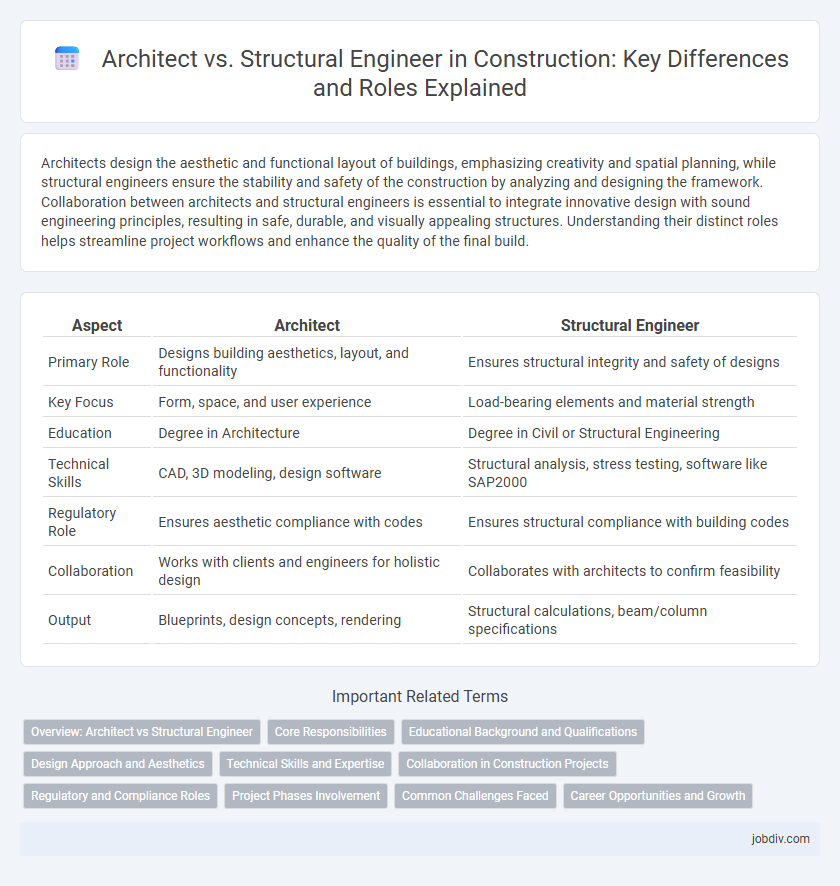Architects design the aesthetic and functional layout of buildings, emphasizing creativity and spatial planning, while structural engineers ensure the stability and safety of the construction by analyzing and designing the framework. Collaboration between architects and structural engineers is essential to integrate innovative design with sound engineering principles, resulting in safe, durable, and visually appealing structures. Understanding their distinct roles helps streamline project workflows and enhance the quality of the final build.
Table of Comparison
| Aspect | Architect | Structural Engineer |
|---|---|---|
| Primary Role | Designs building aesthetics, layout, and functionality | Ensures structural integrity and safety of designs |
| Key Focus | Form, space, and user experience | Load-bearing elements and material strength |
| Education | Degree in Architecture | Degree in Civil or Structural Engineering |
| Technical Skills | CAD, 3D modeling, design software | Structural analysis, stress testing, software like SAP2000 |
| Regulatory Role | Ensures aesthetic compliance with codes | Ensures structural compliance with building codes |
| Collaboration | Works with clients and engineers for holistic design | Collaborates with architects to confirm feasibility |
| Output | Blueprints, design concepts, rendering | Structural calculations, beam/column specifications |
Overview: Architect vs Structural Engineer
Architects focus on designing the aesthetic and functional aspects of buildings, including layouts, materials, and spatial planning, ensuring the structure meets the client's vision and regulatory codes. Structural engineers analyze and design the building's framework to withstand loads and stresses, ensuring safety, stability, and compliance with engineering standards. Collaboration between architects and structural engineers is essential for creating buildings that are both visually appealing and structurally sound.
Core Responsibilities
Architects focus on the design, aesthetics, and functionality of buildings, ensuring spaces are visually appealing and meet client requirements. Structural engineers analyze and design the building's framework, guaranteeing stability, strength, and compliance with safety codes under various loads. Both professionals collaborate closely to integrate creative design with structural integrity in construction projects.
Educational Background and Qualifications
Architects typically hold a professional degree in architecture, such as a Bachelor or Master of Architecture, and must pass the Architect Registration Examination to become licensed. Structural engineers usually earn a degree in civil or structural engineering, often at the Bachelor or Master level, and require Professional Engineer (PE) licensure after gaining relevant work experience. Both professions demand extensive knowledge in their respective fields, with architects focusing on design principles and aesthetics, while structural engineers prioritize building safety, stability, and compliance with engineering codes.
Design Approach and Aesthetics
Architects prioritize creativity and aesthetics in building design, focusing on spatial concepts, materials, and visual harmony to create functional and appealing structures. Structural engineers emphasize safety, stability, and compliance with engineering principles, analyzing loads and stresses to ensure the building withstands environmental forces. Collaboration between architects and structural engineers integrates artistic vision with technical integrity, resulting in structurally sound and visually striking constructions.
Technical Skills and Expertise
Architects specialize in spatial design, aesthetics, and functionality, utilizing software like AutoCAD and Revit to create blueprints and visualizations. Structural engineers focus on analyzing and ensuring the safety, stability, and durability of buildings, applying principles of physics and mathematics with tools such as SAP2000 and ETABS. Their technical expertise intersects in project collaboration, but structural engineers prioritize load calculations, material strength, and compliance with construction codes.
Collaboration in Construction Projects
Collaboration between architects and structural engineers is essential for successful construction projects, ensuring both aesthetic vision and structural integrity are achieved. Architects design the conceptual and functional aspects, while structural engineers analyze load-bearing elements and material strength to guarantee safety and compliance with building codes. Effective communication and early involvement of both professionals reduce conflicts, streamline workflow, and result in cost-efficient, durable structures.
Regulatory and Compliance Roles
Architects ensure building designs comply with zoning laws, accessibility standards, and aesthetic regulations to meet local and national codes. Structural engineers focus on verifying that structural components meet safety codes, load requirements, and seismic or wind resistance regulations through detailed calculations and material specifications. Both roles collaborate closely to guarantee the project adheres to regulatory frameworks and passes mandatory inspections throughout construction.
Project Phases Involvement
Architects lead the conceptual design and schematic phases, developing project vision, spatial layout, and aesthetics. Structural engineers become critical during design development and construction documentation, ensuring building stability, load calculations, and compliance with safety codes. Both collaborate during construction administration to address structural modifications and design intent alignment.
Common Challenges Faced
Architects and structural engineers often face challenges in balancing aesthetic design with structural integrity, requiring continuous collaboration to ensure safety without compromising creativity. Coordination issues can arise from differing technical languages and priorities, making effective communication crucial to resolving design conflicts and meeting project deadlines. Both professionals must navigate regulatory compliance, material limitations, and site-specific constraints while aligning their expertise to achieve a successful construction outcome.
Career Opportunities and Growth
Career opportunities for architects and structural engineers vary significantly, with architects focusing on building design, aesthetics, and spatial functionality while structural engineers specialize in ensuring structural integrity and safety. Growth in architecture careers often leads toward project management, sustainable design, or urban planning, whereas structural engineers tend to advance into roles involving complex analysis, infrastructure development, or specialized engineering consulting. Both professions benefit from continuous education and certification, with high demand in urban development, infrastructure projects, and green building initiatives driving robust career prospects.
Architect vs Structural Engineer Infographic

 jobdiv.com
jobdiv.com